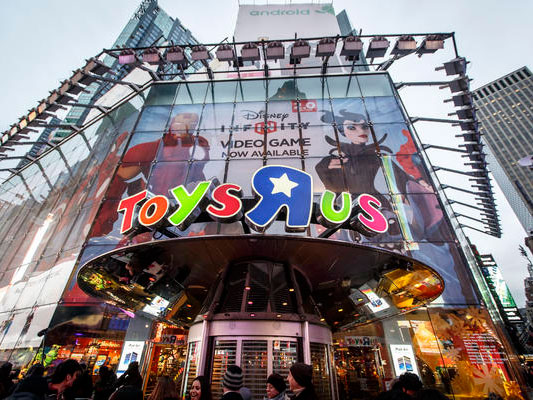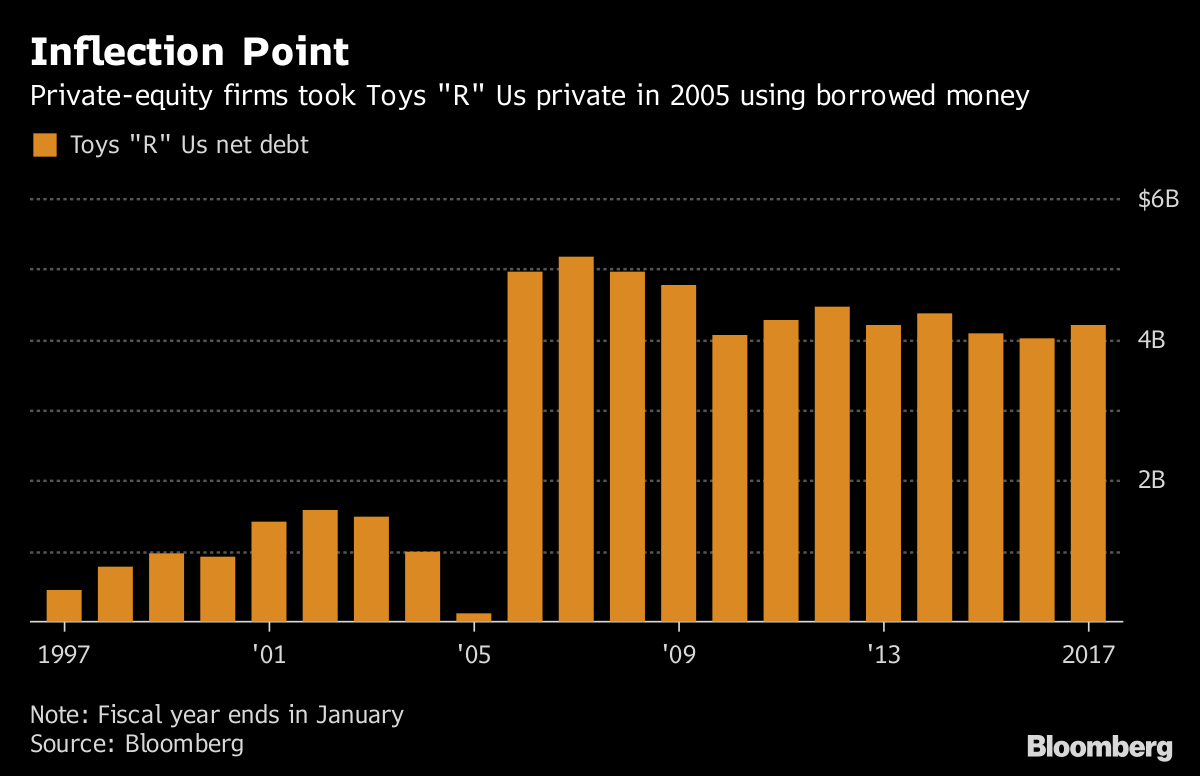
Toys“R”Us, the ultimate toyland for baby boomers and their kids, is going out of business after a failed rescue effort, unable to recover from intense competition and crushing debts.
The collapse, disclosed in a statement Thursday, could shut down hundreds of stores around the world and jeopardize tens of thousands of jobs. Toys“R”Us filed for bankruptcy in September with a plan to turn around the unprofitable retailer. But sales sputtered during the crucial holiday season, and Bloomberg reported that the company began missing payments to some suppliers in recent days, all but sealing its fate.
Watch: Playtime’s Over For Toys‘R’Us
Toys“R”Us filed a motion seeking Bankruptcy Court approval to begin winding down its U.S. business, according to the statement. The company is also pursuing a reorganization and sale of its Canadian division as well as its international operations in Asia and Central Europe.
“I am very disappointed with the result, but we no longer have the financial support to continue the company’s U.S. operations,” CEO Dave Brandon said in the statement. “We are therefore implementing an orderly process to shutter our U.S. operations and will pursue going concern sales or reorganizations of certain of our international businesses, while our other international businesses consider their options.”
Retail Apocalypse
The merchant is among the latest and largest victims of the retail apocalypse that has already felled a host of traditional brick-and-mortar stores, including Sports Authority, Gymboree and Payless. Toys“R”Us suffered as giant discount stores such as Walmart sold the most popular toys at steep markdowns to lure shoppers into the aisles, and more price pressure came from the advent of online merchants such as Amazon.
The company’s official history says it was founded by Charles P. Lazarus, who got his start in his father’s bicycle shop and later opened Children’s Bargain Town in Washington, D.C., after coming home from World War II. The Toys“R”Us logo followed in the late 1950s with a backwards “R” to give the impression that a child wrote it.

Brandon told employees on Wednesday that the chain will be closing its U.S. operations, according to a person with knowledge of the matter. He addressed workers at the company’s headquarters in Wayne, N.J., laying out plans for an orderly shutdown, said the person, who asked not to be identified because the closing at that time wasn’t yet public.
The company’s U.K. unit is also shutting down after a bidder failed to emerge, but a group led by MGA Entertainment had made a bid for the Canadian business, one of the company’s best divisions. Toys“R”Us said Thursday it is engaged in discussions with interested parties for a transaction that could combine as many as 200 of its top performing U.S. stores with its Canadian operations. MGA’s group confirmed that it’s looking at U.S. locations.
See: Toys’R’Us: A How-Not-To Guide for the Retail Business
While Toys“R”Us is seeking a sale of its Central Europe operations — which includes Germany, Austria and Switzerland — its businesses in Australia, France, Poland, Portugal and Spain are considering their options. The company said stores in these international markets are currently open and serving customers.
Creditors Brawl
A liquidation likely will involve a renewed face-off among lenders and bondholders holding about $5 billion of debt as they battle over the remains of the chain. Much of that borrowing was the legacy of a $7.5 billion leveraged buyout in 2005 in which Bain Capital, KKR & Co. and Vornado Realty Trust loaded the company with debt to take it private. Toymakers Mattel and Hasbro may also suffer, with their shares already hovering near 12-month lows.
When it filed for bankruptcy court protection, the company counted nearly 65,000 employees working at 885 Toys“R”Us and Babies“R”Us stores in the U.S., Puerto Rico and Guam, and more than 810 international stores and over 255 licensed stores in 38 countries.
Brandon, who oversaw a turnaround at Domino’s Pizza, took over the top job at Toys“R”Us in 2015, and he initially bought time for a turnaround with a financial overhaul that put off some of its debt maturities. The affection of shoppers was still there, but he saw that service was spotty and shelves were sometimes empty. The chain also was losing touch with the next generation of parents, and he went scouting for smaller locations in New York and other cities that the chain had abandoned because of high rents.
‘We’re Nowhere’
“When it comes to all those millennials who want to live in those urban centers, we’re nowhere,” Brandon said in a 2016 interview.
Down in the aisles, the plan was to lure more customers by making the shopping experience more fun, with product demonstrations and the “Hot Toy Finder” to help locate the must-have items that made it a go-to destination.
See: Selfie Journals & Viper Drones: Tech Toys Grow Up To Keep Up
Brandon, with more than half a dozen young grandchildren of his own, had a vision of kids “dragging their parents to our stores because they want to see what’s going on.” Stores tested video screens, sound effects and colorful motion-sensor lights. They unboxed more toys in play areas, with drones flying in the aisles and spots for Nerf blaster target practice. They hosted more events, such as Pokemon trading and birthday celebrations. Collectively, it was a throwback to an era when retailing was more theater than science.
In the end, though, parents could buy the exact same playthings at rivals like Walmart and Target and Amazon, which sometimes used the hottest toys as loss leaders while making it back on their huge array of household goods and groceries. Suppliers lost confidence as sales wobbled at Toys “R” Us, and so did debtholders. They ultimately decided it was too risky to keep funding the retailer, and pulled the plug.
From Bloomberg











